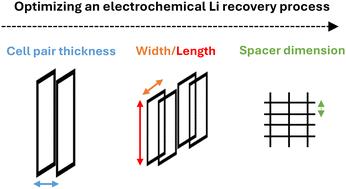利用电化学膜分离评估锂回收:成本分析和设计策略
IF 9.2
1区 化学
Q1 CHEMISTRY, MULTIDISCIPLINARY
引用次数: 0
摘要
对锂基化学品日益增长的需求要求可持续回收技术的进步。离子交换膜,如锂超离子导体,提供了有前途的电化学解决方案。然而,电化学基本原理与技术经济可行性之间的关系仍未得到充分探讨。本文分析了综合Li2CO3生产工艺的技术经济评价,包括盐水的吸收和预处理、直接电化学锂回收、盐水处理和LiCl转化为电池级Li2CO3。我们开发了一种优化方法,该方法考虑了盐水成分(锂:0.17-710 ppm)和锂选择膜价格(每平方米500 - 40000美元)的变化,以建立堆栈设计和操作指南,以最大限度地减少每天生产1吨Li2CO3的能源和材料消耗。我们考察了Li/Ca和Li/Mg选择性、堆压降极限和低采收率下的操作。虽然20 bar的压力阈值被认为是节省成本的最佳选择,但我们强调了另一种策略,即将较低的采收率与自适应电化学设计相结合,在不需要更高耐压能力的情况下进一步降低成本。虽然从海水中回收锂的成本仍然很高,但我们的研究结果表明,对于其他卤水来源,假设锂转移数为1,每吨Li2CO3的生产成本在2600美元到28000美元之间,能源消耗从5099到71 099千瓦时不等,具体取决于锂浓度和膜价格。然而,在较低的二元选择性(~ 22 ~ ~ 5)下,能量需求可能增加170%至900%以上,这主要是由于更高的电流密度和电压要求。我们的工作为从盐水中有效地直接回收锂提供了指导方针,为更可持续的锂采购铺平了道路。本文章由计算机程序翻译,如有差异,请以英文原文为准。

Evaluating lithium recovery using electrochemical membrane separation: cost analysis and design strategies
The increasing demand for Li-based chemicals necessitates advancements in sustainable recovery technologies. Ion-exchange membranes, such as Li superionic conductors, offer promising electrochemical solutions. However, the relationship between electrochemical fundamentals and techno-economic feasibility remains underexplored. This analysis presents a techno-economic evaluation of an integrated Li2CO3 production process, covering brine intake and pretreatment, direct electrochemical Li recovery, brine disposal, and LiCl conversion to battery-grade Li2CO3. We develop an optimization method that accounts for variations in brine composition (Li: 0.17–710 ppm) and Li-selective membrane prices ($500–$40 000 per m2) to establish stack design and operational guidelines to minimize energy and material consumption in producing 1 ton of Li2CO3 per day. We examine Li/Ca and Li/Mg selectivity, stack pressure drop limits, and operation at reduced recovery ratios. While a 20-bar pressure threshold is identified as optimal for cost savings, we highlight an alternative strategy – combining lower recovery ratios with adaptive electrochemical design – to further minimize costs without requiring higher pressure tolerance. While Li recovery from seawater remains costly, our findings indicate that for other brine sources, assuming a Li transference number of 1, production costs range from $2600 to $28 000 per ton of Li2CO3, with energy consumption varying from 5099 to 71 099 kWh, depending on Li concentration and membrane price. However, energy demand can increase by 170% to over 900% at lower binary selectivities of ∼22 to ∼5, primarily due to higher current density and voltage requirements. Our work provides guidelines on an efficient direct Li recovery from brines, paving the way to a more sustainable Li sourcing.
求助全文
通过发布文献求助,成功后即可免费获取论文全文。
去求助
来源期刊

Green Chemistry
化学-化学综合
CiteScore
16.10
自引率
7.10%
发文量
677
审稿时长
1.4 months
期刊介绍:
Green Chemistry is a journal that provides a unique forum for the publication of innovative research on the development of alternative green and sustainable technologies. The scope of Green Chemistry is based on the definition proposed by Anastas and Warner (Green Chemistry: Theory and Practice, P T Anastas and J C Warner, Oxford University Press, Oxford, 1998), which defines green chemistry as the utilisation of a set of principles that reduces or eliminates the use or generation of hazardous substances in the design, manufacture and application of chemical products. Green Chemistry aims to reduce the environmental impact of the chemical enterprise by developing a technology base that is inherently non-toxic to living things and the environment. The journal welcomes submissions on all aspects of research relating to this endeavor and publishes original and significant cutting-edge research that is likely to be of wide general appeal. For a work to be published, it must present a significant advance in green chemistry, including a comparison with existing methods and a demonstration of advantages over those methods.
 求助内容:
求助内容: 应助结果提醒方式:
应助结果提醒方式:


